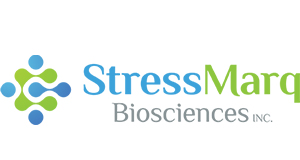Alpha Synuclein Antibody (Aggregate-Specific), Clone 2F11: ATTO 594
Mouse Anti-Mouse Alpha Synuclein Aggregate Antibody Monoclonal IgG1
Artikelnummer
STRSMC-617D-A594
Verpackungseinheit
100 µg
Hersteller
Stressmarq Biosciences
Verfügbarkeit:
wird geladen...
Preis wird geladen...
Target: Alpha Synuclein Aggregate Antibody
Conjugate: ATTO 594
Product Type: Monoclonal
Clone Number: 2F11
Immunogen: Mouse alpha synuclein fibrils
Swiss-Prot: O55042
Purification: Protein G Purified
Storage Buffer: 640.91mM DMSO, 136.36mM Ethanolamine, 9.09mM Sodium Bicarbonate in 90.9% PBS
Concentration: 1mg/ml
Specificity: This antibody binds a 3-dimensional fibrillar epitope of alpha synuclein (including AA101-120, AA61-80), present in MSA (Multiple System Atrophy) aggregates in human brain samples. It does not appear to detect PD (Parkinson's disease) or PDLB (Parkinson's disease with Lewy Bodies) aggregate structures in human brain samples. It can, however, bind recombinant human PFFs and mouse PFFs.
Cellular Localization: Cell Junction, Cytoplasm, Cytosol, Membrane, Nucleus, Synapse
Scientific Background: Alpha-Synuclein (SNCA) is expressed predominantly in the brain, where it is concentrated in presynaptic nerve terminals (1). Alpha-synuclein is highly expressed in the mitochondria of the olfactory bulb, hippocampus, striatum and thalamus (2). Functionally, it has been shown to significantly interact with tubulin (3), and may serve as a potential microtubule-associated protein. It has also been found to be essential for normal development of the cognitive functions; inactivation may lead to impaired spatial learning and working memory (4). SNCA fibrillar aggregates represent the major non A-beta component of Alzheimer’s disease amyloid plaque, and a major component of Lewy body inclusions, and Parkinson's disease. Parkinson's disease (PD) is a common neurodegenerative disorder characterized by the progressive accumulation in selected neurons of protein inclusions containing alpha-synuclein and ubiquitin (5, 6). Covered by US patent family US11,098,108B2 (7).
References: 1. “Genetics Home Reference: SNCA”. US National Library of Medicine. (2013).2. Zhang L., et al. (2008) Brain Res. 1244: 40-52.3. Alim M.A., et al. (2002) J Biol Chem. 277(3): 2112-2117.4. Kokhan V.S., Afanasyeva M.A., Van'kin G. (2012) Behav. Brain. Res. 231(1): 226-230.5. Spillantini M.G., et al. (1997) Nature. 388(6645): 839-840.6. Mezey E., et al. (1998) Nat Med. 4(7): 755-757.7. Louwrier, A. US Patent family US11,098,108 B2
Field of Use: Not for use in humans. Not for use in diagnostics or therapeutics. For in vitro research use only.
Conjugate: ATTO 594
Product Type: Monoclonal
Clone Number: 2F11
Immunogen: Mouse alpha synuclein fibrils
Swiss-Prot: O55042
Purification: Protein G Purified
Storage Buffer: 640.91mM DMSO, 136.36mM Ethanolamine, 9.09mM Sodium Bicarbonate in 90.9% PBS
Concentration: 1mg/ml
Specificity: This antibody binds a 3-dimensional fibrillar epitope of alpha synuclein (including AA101-120, AA61-80), present in MSA (Multiple System Atrophy) aggregates in human brain samples. It does not appear to detect PD (Parkinson's disease) or PDLB (Parkinson's disease with Lewy Bodies) aggregate structures in human brain samples. It can, however, bind recombinant human PFFs and mouse PFFs.
Cellular Localization: Cell Junction, Cytoplasm, Cytosol, Membrane, Nucleus, Synapse
Scientific Background: Alpha-Synuclein (SNCA) is expressed predominantly in the brain, where it is concentrated in presynaptic nerve terminals (1). Alpha-synuclein is highly expressed in the mitochondria of the olfactory bulb, hippocampus, striatum and thalamus (2). Functionally, it has been shown to significantly interact with tubulin (3), and may serve as a potential microtubule-associated protein. It has also been found to be essential for normal development of the cognitive functions; inactivation may lead to impaired spatial learning and working memory (4). SNCA fibrillar aggregates represent the major non A-beta component of Alzheimer’s disease amyloid plaque, and a major component of Lewy body inclusions, and Parkinson's disease. Parkinson's disease (PD) is a common neurodegenerative disorder characterized by the progressive accumulation in selected neurons of protein inclusions containing alpha-synuclein and ubiquitin (5, 6). Covered by US patent family US11,098,108B2 (7).
References: 1. “Genetics Home Reference: SNCA”. US National Library of Medicine. (2013).2. Zhang L., et al. (2008) Brain Res. 1244: 40-52.3. Alim M.A., et al. (2002) J Biol Chem. 277(3): 2112-2117.4. Kokhan V.S., Afanasyeva M.A., Van'kin G. (2012) Behav. Brain. Res. 231(1): 226-230.5. Spillantini M.G., et al. (1997) Nature. 388(6645): 839-840.6. Mezey E., et al. (1998) Nat Med. 4(7): 755-757.7. Louwrier, A. US Patent family US11,098,108 B2
Field of Use: Not for use in humans. Not for use in diagnostics or therapeutics. For in vitro research use only.
| Artikelnummer | STRSMC-617D-A594 |
|---|---|
| Hersteller | Stressmarq Biosciences |
| Hersteller Artikelnummer | SMC-617D-A594 |
| Verpackungseinheit | 100 µg |
| Mengeneinheit | STK |
| Reaktivität | Human, Mouse (Murine) |
| Klonalität | Monoclonal |
| Methode | Immunofluorescence, Immunohistochemistry, Immunocytochemistry |
| Isotyp | IgG1 |
| Human Gene ID | 20617 |
| Wirt | Mouse |
| Konjugat | Conjugated, Atto 594 |
| Produktinformation (PDF) | Download |
| MSDS (PDF) | Download |

 English
English







